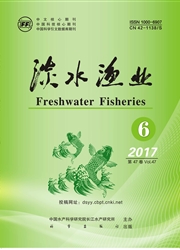

 中文摘要:
中文摘要:
研究了水体中铅(Pb)对南方鲇(Silurus meridionalis)幼鱼和和胭脂鱼(Myxocyprinusasiaticus)幼鱼的生态毒性效应。以人工配制软水(CaCO,25mg/L)为实验水体,在27.5℃条件下,通过急性暴露实验,测得水体中Ph对南方鲇和胭脂鱼的96h急性半致死浓度(96h LG50)分别为4.47mg/L和0.264mg/L。在水体中不同Pb浓度条件下,分别对南方鲇(在0、200和400μg/L的Pb浓度下)和胭脂鱼(在0、10和50ug/L的Pb浓度下)进行了为期8周的慢性暴露处理实验。观测结果显示,南方鲇和胭脂鱼的肝脏、肾脏和鳃中谷胱甘肽S-转移酶(GST)活性均随水体中Pb浓度升高而升高。两种实验鱼的静止代谢率和肝脏(或肝胰脏)的线粒体状态3呼吸率均随着水体中Pb浓度的升高而逐渐升高;鱼体内的能量储备物质也会发生相应的改变,肝脏中糖原含量随Pb暴露浓度的升高而呈下降趋势。两种实验鱼的特定体重生长率均随Pb暴露浓度的升高而逐渐下降,高浓度处理组均显著高于对照组。结果表明:南方鲇对Pb的耐受能力较强;胭脂鱼对Pb的耐受能力很低,在水体Ph的慢性暴露处理下,两种鱼的生长速率均会受到不同程度的抑制。
 英文摘要:
英文摘要:
The ecotoxicological effects of water-borne lead (Pb) in artificial soft water (25 mg CaCO3/L) on the southern catfish (Silurus meridionalis) and the Chinese sucker (Myxocyprinus asiaticus) were observed at 27.5 ~C. The median le- thal concentration of S. meridionalis and M. asiaticus in 96 hours (96 h LCso) were 4. 47 and 0. 264 mg/L respectively in a- cute toxicity experiment. The toxic effects of Pb at control, medium and high concentrations on S. meridionalis (0, 200 and 400 ~g Pb/L) and M. asiaticus (0, 10 and 50 p~g Pb/L) were examined after 8-week chronic exposure experiment. The activities of Glutathione S Transferases (GST) in liver (hepatopancreas), gill and kidney of the tested fish increased with Ph concentration increasing. Both the resting metabolic rates of individuals and mitochondrial state 3 respiration rates of liver (or hepatopancreas) increased with Pb concentration increasing. Meanwhile, energy storage changed accordingly. The glycogen content in liver (hepatopancreas) decreased with Pb exposure concentrations increasing. The specific growth rates of all fish decreased with Pb concentration increasing, and the values in high Pb groups were significantly lower com- pared with control groups, respectively. It was suggested that S. meridionalis had high tolerance for lead toxicity. On the contrary, M. asiaticuz had low tolerance for lead toxicity. With the chronic treatment of water-borne Pb exposure, the growth rates of the two species were depressed at different degree.
 同期刊论文项目
同期刊论文项目
 同项目期刊论文
同项目期刊论文
 期刊信息
期刊信息
